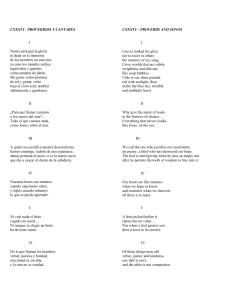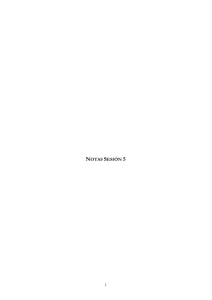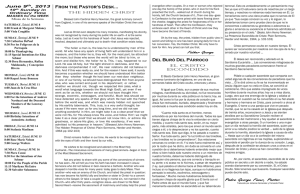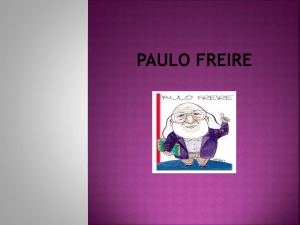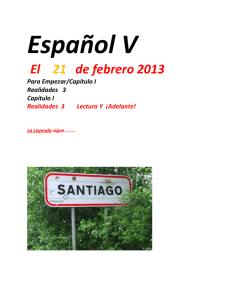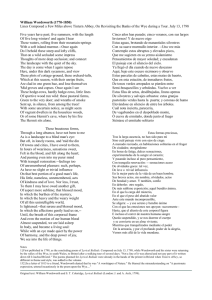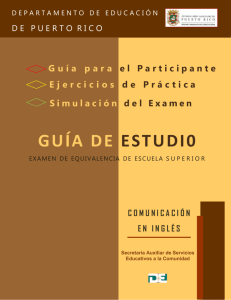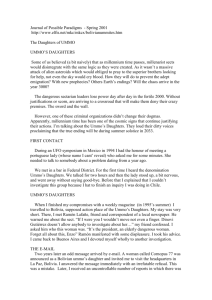bicentenario - Chile en el Exterior
advertisement
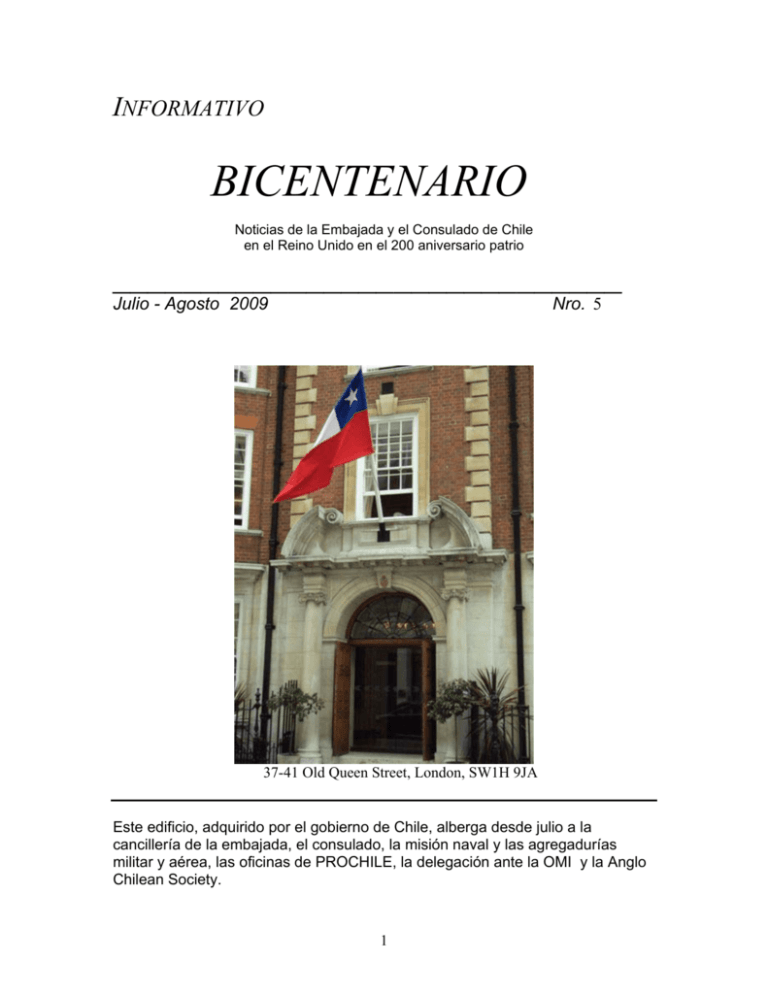
INFORMATIVO BICENTENARIO Noticias de la Embajada y el Consulado de Chile en el Reino Unido en el 200 aniversario patrio _____________________________ Julio - Agosto 2009 Nro. 5 37-41 Old Queen Street, London, SW1H 9JA Este edificio, adquirido por el gobierno de Chile, alberga desde julio a la cancillería de la embajada, el consulado, la misión naval y las agregadurías militar y aérea, las oficinas de PROCHILE, la delegación ante la OMI y la Anglo Chilean Society. 1 NUEVA SEDE DE LA EMBAJADA DE CHILE Y, finalmente, ocurrió. La sede de la Embajada de Chile en Londres, conjuntamente con el consulado y la misión militar, se mudaron- el 8 de julio- a las nuevas dependencias. Se trata de un edificio de nueve pisos en el exclusivo barrio de Westminster, comprado –por vez primera-por el gobierno de Chile. En las semanas siguientes, harían lo mismo la agregaduría aérea y la misión naval, así como ProChile, la oficina comercial. Como una foto vale mil palabras, aquí va una muestra de las nuevas oficinas. Fachada de la nueva embajada Despacho del embajador Sala de espera del consulado 2 VISITA DE COMANDANTE EN JEFE DE LA FUERZA AEREA El general Ricardo Ortega, comandante en Jefe de la Fuerza Aérea de Chile (FACh), llegó a Londres el 15 de julio, invitado por el air chief marshal de la Royal Air Force (RAF), su par británico, Sir Glenn Torpy a participar en el llamado y prestigioso Royal International Air Tattoo, que se realiza cada año en Fairford Swindon, Inglaterra. Este evento aéreo internacional -RIAT es la sigla en inglés- es una de las demostraciones aéreas más antiguas e importantes del mundo, en la cual participan diversos equipos acrobáticos (el año pasado fue invitada la Escuadrilla Alta Acrobacia de la FACh "Halcones"). Se trata, asimismo, de una instancia para que los invitados puedan iniciar y/o continuar con intercambios en los diferentes ámbitos de desarrollo que competen a las fuerzas aéreas a nivel internacional. Durante su estada en Inglaterra, el comandante en jefe de la FACh visitó al embajador de Chile en el Reino Unido Rafael Moreno en las nuevas dependencias de la embajada en el barrio de Westminster. General Ricardo Ortega y embajador Rafael Moreno 3 CONDECORACION A MARCIAL ECHENIQUE Comandante en jefe de la Fuerza Aérea general Ricardo Ortega; embajador Rafael Moreno; Gloria Orb de Moreno; María Luisa Holzmann de Echeñique; Marcial Echeñique El connotado arquitecto chileno, Marcial Echeñique, ex decano de la Escuela de Arquitectura de la Universidad de Cambridge, recibió -el 15 de julio en el Palacio de Buckingham- de manos de la Reina Isabel II, la distinción Orden del Imperio Británico (Order of the British Empire, OBE) por sus “servicios a la planificación urbana y regional.” Ese mismo día, el embajador de Chile en el Reino Unido Rafael Moreno ofreció una cena en su honor en la residencia, a la cual asistieron amigos, representantes del mundo académico, docente y diplomático. Echenique, experto internacional en planificación urbana y regional, es jefe del Departamento de Uso de Tierras y Estudios de Transporte de la Universidad de Cambridge desde 1993 y jefe del departamento de Arquitectura desde 2004. Echeñique es un fellow de Churchill College, Cambridge. Asimismo, ha estado involucrado en el desarrollo de ciudades a nivel mundial y ha sido consultor para diversos gobiernos y entidades internacionales, entre ellas, el Banco Mundial y las Naciones Unidas. 4 CULTURA FELIPE BROWNE Una pasión melodiosa En la antigua y bella iglesia de Saint Mary’s, en el barrio Barnes de Londres, Felipe Browne, pianista chileno de fama internacional, ofreció un concierto memorable. Ante más de un centenar de personas, este artista santiaguino (casado, cinco hijos) interpretó piezas de Chopin (Allegro Maestoso, Sonata No.3 Op. En B menor, entre otras) y Liszt (Soneto del Petrarca, Ballade en B menor, entre otras). El dinero recaudado por las entradas y la venta de su CD irá en beneficio de una escuela primaria católica de St. Osmund. Browne comenzó sus lecciones de piano en Santiago y en 1984 su talento fue reconocido por el maestro Caludio Arrau. En 1988, tras graduarse de cómo concertista de piano de la Universidad Católica, fue invitado por Arie Vardi a estudiar en Israel. Siguiendo el consejo de Vardi, Browne se mudó a Londres para continuar sus estudios con meter Feuchtwanger por tres años. Luego, regresó a Chile a enseñar piano en el Instituto de Música de Santiago. Entre 1998 y 2002 Felipe se radicó en Londres, patrocinado por el Ministerio de Relaciones Exteriores de Chile. En 2007 fue la figura elegida para abrir el llamado Circle of grand Pianists en el Teatro Municipal de Santiago y, en octubre de 2008, volvió a participar en este evento. 5 LIBROS Relanzamiento de “Arena Negra” En pleno verano inglés, el 23 de julio, se efectuó el relanzamiento de la novela “Arena Negra” (Random House Mondadori) de la periodista Odette Magnet, agregada de prensa de la Embajada de Chile en Londres. Con la asistencia de más de 65 personas, el evento marcó el estreno de las nuevas oficinas de la Embajada de Chile, el consulado y otras unidades (ver crónica aparte). Hizo la presentación el embajador de Chile ante el Reino Unido Rafael Moreno, quien expresó: ” La historia aquí narrada no tiene tiempos distintos, es una sola vorágine que con su ritmo solo permite descansar cuando se cierra la ultima pagina. Sus episodios se entrelazan y nominarlos, fuera de ser casi imposible, habría mutilado esta historia de amor, lagrimas y esperanzas.” En una breve intervención, la autora dijo que “como periodista, mi verbo preferido es compartir. El periodista escribe para comunicar, para servir por medio de la información veraz y hacer comunidad, patria o futuro con la propuesta de pensar en plural.” Y agregó: “El escritor o la escritora no tiene, necesariamente, esa obligación social ni debe apegarse a la verdad. Más bien por el contrario, debe sonar profundo, volar alto, batir sus alas hasta que ellas aleteen libres, impulsadas por los vientos de la imaginación, la creatividad y la audacia.” La novela aún no es traducida al inglés. 6 CEREMONIA EN RICHMOND Bernardo O”Higgins en la memoria Ingleses y chilenos se dieron cita hoy en la localidad de Richmond, a orillas del Támesis, en Inglaterra, para conmemorar el 231 aniversario del nacimiento de Bernardo O’Higgins Riquelme. La ceremonia, breve y sencilla, fue encabezada por la alcaldesa del pueblo Celia Hodges y el embajador de Chile en el Reino Unido Rafael Moreno. Las autoridades depositaron ofrendas florales frente al monumento del libertador, ubicado en la pequeña plaza que lleva el nombre del prócer chileno. Esta tradición se inició en 1998. O’Higgins vivió tres años en Richmond, donde estudió, aprendió el inglés y tomó contacto con los próceres americanistas Simón Bolívar, José de San Martín y Francisco de Miranda. La alcaldesa Hodges expresó que “es un placer darle la bienvenida a Richmond al embajador en esta ceremonia que celebra Alcaldesa Celia Hodges y embajador Rafael Moreno nuestros vínculos con uno de los hombres más influyentes que haya vivido en este condado. Nos sentimos extremadamente orgullosos por este lazo con Chile y, una vez más, reafirmamos nuestra amistad con el pueblo chileno.” Por su parte, el embajador Rafael Moreno dijo: “En el 2010, Chile celebrará sus 200 años de vida republicana. Es una excusa genial para pensar en nuestro país, cómo lo soñamos y en el pasado que está tras nuestro. No puedo dejar de pensar en Bernardo O’Higgins, una fugura clave en permitir que esto fuera possible y una referencia histórica obligada.” “Creo que O’Higgins”, agregó Moreno, “estaría complacido y orgulloso de unirse a nuestra celebración del bicentenario de nuestro país. Sus sueños son aún en buena parte los nuestros y le debemos mucho. Por eso es que estamos hoy aquí para honrar su nombre y reconocer su aporte a nuestra historia nacional.” Después del acto, los asistentes disfrutaron de un vino de honor. 7 PREMIO NACIONAL DE EDUCACION 2009 El Ministerio de Educación entregó los Premios Nacionales de Periodismo, Educación, Artes y ciencias, correspondientes al año 2009. El galardonado por Ciencias de la Educación fue el profesor Mario Leyton Soto, educador con más de 50 años de trabajo dedicado a la docencia y la investigación. Se trata de uno de los pilares de la reforma educacional iniciada en 1964 y destacado investigador del Centro de Perfeccionamiento, Experimentación e Investigación Pedagógicas. De acuerdo al nuevo Premio Nacional, el tema pendiente en materia educativa es la revalorización de los profesores en la sociedad y su constante perfeccionamiento. PREMIO NACIONAL DE PERIODISMO 2009 María Olivia Monckeberg, Premio Nacional de Periodismo 2009, se desempeña como profesora titular de la Universidad de Chile, donde dicta clases en la Escuela de Periodismo y en la de Ciencias Físicas y Matemáticas, además de encabezar la Unidad de Periodismo de Investigación, del Instituto de la Comunicación e Imagen. La profesional se ha destacado en el periodismo de investigación en Chile. Entre sus libros destacan: "El Saqueo de los grupos económicos al Estado chileno", sobre las privatizaciones de empresas públicas durante el régimen militar y "El Imperio del Opus Dei en Chile". Además escribió dos libros sobre las instituciones de educación superior: "La privatización de las universidades: Una historia de dinero, poder e influencias" y "El negocio de las universidades en Chile". En 1986 publicó como coautora, junto a María Eugenia Camus y Pamela Jiles el libro "Crimen bajo Estado de Sitio", sobre los asesinatos de los profesores José Manuel Parada, Santiago Nattino y Manuel Guerrero. PREMIO NACIONAL DE ARTES 2009 El escultor especializado en hormigón, Federico Assler obtuvo el Premio Nacional de Artes. El destacado artista estudió arquitectura dos años en la Universidad Católica de Valparaíso y luego se inició en los talleres de dibujo de la Escuela de Bellas Artes de la Universidad de Chile. Assler está próximo a celebrar los 40 años desde que expuso en el Museo Nacional de Bellas Artes de Santiago con una nueva muestra de sus esculturas. Dedicó el premio a su hijo Benajamín, fallecido hace tres años luego de ser atropellado cuando iba camino a la Escuela de Arquitectura. El artista manifestó que la forma en que llega a terminar sus esculturas es al revés de lo tradicional, elaborando primero un molde, el cual rellena con hormigón y finalmente termina de esculpir el elemento. PREMIO NACIONAL DE CIENCIAS 2009 El ingeniero matemático Ricardo Baeza se adjudicó el Premio Nacional de Ciencias 2009, según resolvió el jurado encabezado por la ministra de Educación, Mónica Jiménez. El profesor del Instituto de Matemáticas y Física de la Universidad de Talca y doctor en Recursos Naturales de la Universitat des Saarlandes, Alemania, Baeza fue reconocido por su trabajo en el área de la ciencia vinculada a álgebra y la teoría de los números. Baeza se desempeña desde el año 2004 como director de un Anillo de Ciencia y Tecnología del Programa Bicentenario de la Comisión Nacional de Investigación Científica y Tecnológica (Conicyt). 8 BECAS PARA CHILENOS EN EL EXTRANJERO Becas de Magíster y Doctorado La Comisión Nacional de Investigación Científica y Tecnológica, CONICYT, a través de su Programa de Capital Humano Avanzado y en el marco de Becas Chile, cuenta con los concursos de becas para realizar doctorado y magíster en el extranjero.El objetivo de estos concursos es formar Capital Humano Avanzado en todas las áreas del conocimiento, que contribuya al desarrollo científico, académico, económico, social y cultural del país. Ambos concursos están dirigidos a chilenos/as y/o extranjeros/as con permanencia definitiva en Chile, para iniciar y/o continuar estudios conducentes a la obtención del grado académico de Magíster y Doctorado en instituciones de excelencia en el exterior. Entre los beneficios a los que se puede acceder están: pasaje de ida y vuelta para el beneficiario -y su familia si corresponde-; arancel y matrícula del programa de estudios; asignación de dinero por concepto de manutención mensual y acorde al costo de vida del país donde se realizará el programa de postgrado; prima anual de seguro médico y asignación para compra de libros. POSTDOCTORADOS Esta convocatoria abrió el 20 de agosto del 2009. La postulación en línea vence el 29 de octubre de 2009 a las 12:00 hrs. (medio día hora chilena).No existen inconvenientes para que postule desde el extranjero, siempre y cuando cumpla con todos los requisitos establecidos en las bases de postulación. Igualmente, si postula en papel, debe asegurarte de enviar todos los documentos en dos copias de dossier a la Oficina de Partes de CONICYT ubicada en calle Bernarda Morin 551, 1er. Piso – Providencia, Santiago. Las postulaciones a las universidades son autogestionadas, esto significa que la convocatoria, está orientada a postulantes que se encuentren aceptados/as por la institución en la que realizarán el Postdoctorado. La universidad y/o centro de investigación es de libre elección y la gestión de su aceptación dentro de la unidad académica o de investigación es responsabilidad de el/ la postulante.No existe un límite de edad como requisito para postular a las becas pertenecientes al Sistema BECAS CHILE. La Beca de Postdoctorado tendrá un duración mínima de seis meses y una máxima de veinticuatro, contados a partir de la fecha de ingreso del/la becario/a al Postdoctorado y sujeto al rendimiento y resultados de la investigación realizada por el/la becario/a. Al término de la beca, el/la becario/a tendrá un plazo de doce meses para retornar a Chile y deberá acreditar su permanencia en Chile por el doble del periodo de duración de la beca. Para regiones distintas de la Región Metropolitana, la permanencia deberá ser al menos por la duración de la beca. El becario deberá iniciar el Postdoctorado antes del 31 de diciembre del año 2010. Para mayores detalles, consulte www.becaschile.cl . 9 CHILE EN LA PRENSA INGLESA THE ECONOMIST July 30 2009 SANTIAGO Chile's stricken salmon farms Dying assets A bankrupt industry faces reform THIS time two years ago some 300m Atlantic salmon were being fattened in farms off the coast of southern Chile. Now its sheltered bays contain just a tenth of that number. Many fish have died of infectious salmon anaemia (ISA), a virus, whereas others have been prematurely harvested for fear they would catch it too. Coho salmon and trout, which Chile also produces, are not susceptible to ISA. Even so, output of the country's fish farms this year is expected to be down by at least 40%. The industry faces a long road back to health. This blow comes after 15 years of meteoric growth that saw exports rise more than tenfold to $2.3 billion in 2007, turned Chile into the world's second-biggest salmon producer after Norway, and brought prosperity to a far-flung area with few other jobs. Salmon farms in Norway, Scotland and Canada have all suffered ISA too. Even so, Chile seems to have been unprepared for the virus when it turned up,apparently in imported salmon eggs. The farmers seem to have been blinded by booming profits. The National Fisheries Service, the industry's regulator which is more used to policing catch quotas at sea, lacked both a plan and the powers to deal with ISA. The resulting disaster has bankrupted the industry, which had piled up $1.8 billion in bank debts by last December. With over half of salmon farms now empty of fish, the industry has the chance to restock and start again, says César Barros of SalmonChile, the industry association. He reckons output will be back to its 2007 level within four years. It could take longer. Congress is, slowly, debating a bill to regulate the industry more tightly. The fisheries service will have to be strengthened. And the farms need working capital to restock. The banks may not oblige, although they have renegotiated much of the debt. The industry has also come up with a voluntary plan to reduce the use of antibiotics to control disease-a practice which has harmed the image of Chilean salmon in the United States. Hitherto, lower production costs allowed Chilean salmon to compete in the United States against less distant rivals. The reforms might erode that advantage-but perhaps not if they work: salmon farmers hope that fewer dead fish will compensate for the cost of cleaning up their act. 10 THE INDEPENDENT World's biggest telescope will see deep into the past Wednesday, 22 July 2009 The world's biggest telescope will be built in Hawaii. The device will be so powerful that it will allow scientists to see some 13 billion light years away and get a glimpse into the early years of the universe. The telescope's mirror - stretching almost 30 metres in diameter, or nearly the length of a Boeing 737's wingspan - will be so large that it should be able to gather light that will have spent 13 billion years travelling to earth. This means astronomers looking into the telescope will be able to see images of the first stars and galaxies forming - some 400 million years after the Big Bang. "It will sort of give us the history of the universe," Thirty Meter Telescope Observatory spokesman Charles Blue said. The telescope, expected to be completed by 2018, will be located atop a dormant volcano that is popular with astronomers because its summit sits well above the clouds at 13,796 feet (4,205 meters), offering a clear view of the sky above for 300 days a year. Hawaii's isolated position in the middle of the Pacific Ocean also means the area is relatively free of air pollution. Few cities on the Big Island mean there aren't a lot of man-made lights around to disrupt observations. The other finalist candidate site for the Thirty Meter Telescope was Chile's Cerro Armazones mountain. Richard Ellis, astronomy professor the California Institute of Technology and a Thirty Meter Telescope board member, told reporters in a conference call that Mauna Kea is at a higher elevation, its air is drier and its average temperature fluctuates less during the course of the day all helpful factors for those using the new telescope. The telescope will be built by the University of California, the California Institute of Technology and the Association of Canadian Universities for Research in Astronomy. The current world's largest telescopes also are located atop Mauna Kea, but the size of their diameters are about three times smaller than the Thirty Meter Telescope. Current telescopes also don't routinely offer views of hundreds of planets orbiting around other stars and stars that are near the sun like the new telescope will. But it may not hold the world's largest title for long. A partnership of European countries plans to build the European Extremely Large Telescope, which would have a 42-metre mirror. The group is considering sites in Argentina, Chile, Morocco and Spain. It plans to decide on a location next year and be able to host its first observation in 2018. 11 Another group of universities plans to finish the Giant Magellan Telescope, also around 2018, with an 24-metre mirror in Las Campanas, Chile. Rolf Kudritzki, the director of Institute for Astronomy at the University of Hawaii, said Hawaii's northern hemisphere location will help the Thirty Meter Telescope complement other large telescopes planned for Chile in the southern hemisphere. "I think all of the astronomers in the world can be happy because in principle now the two largest telescopes will be able to cover the whole sky. And for research that's an important decision," he said. It will also be a special boon to Hawaii astronomers, who will be allotted a share of the TMT's observation time. Kudritzki said his colleagues held an impromptu celebratory party Tuesday. But the decision invited protests from some Native Hawaiian and environmental groups. Native Hawaiian tradition holds that high altitudes are sacred and are a gateway to heaven. In the past, only high chiefs and priests were allowed at Mauna Kea's summit. The mountain is home to one confirmed burial site and perhaps four more, and environmentalists oppose the telescope on the grounds it would hurt some endangered species. "This the kind of legacy they want to leave? They just keep building on our mountain," said Kealoha Pisciotta, president of Mauna Kea Anaina Hou, a group with family and religious ties to the mountain. THE GUARDIAN Wednesday 29 July 2009 Latin America's swing to the right Progressive parties across Latin America can't find charismatic leaders and are losing ground to their rightwing opponents Rodrigo Orihuela A new political trend is taking shape in Latin America. For the past six years or so, international political talk about the region has been all about voters’ swirl to the left and the under-reported story is the re-emergence of the right. Chile, Uruguay and Brazil are the three countries in the region that best epitomise the mellow, well-behaved left that the international right is willing to praise from time to time – as opposed to Ecuador, Nicaragua, Venezuela and Bolivia. Their governments are seen as financially responsible, have a good number of socially-friendly policies and the three presidents – Michelle Bachelet, Tabaré Vázquez and Lula – are both respected abroad and very popular at home. The three countries are also in the midst of presidential election campaigns. Uruguayans will be going to the polls in October and Chileans in December, and while the Brazilian election is set for October 2010, the campaign is already in its initial stages. One could rightfully suppose that the left is cruising to victory. Strikingly though, the frontrunners are all centre-to-right. Optimists believe the tide may still change in favour of the progressive candidates. According to surveys, the Socialist candidate in Uruguay, José “Pepe” Mujica, leads the race by four points over the main conservative candidate, the former president (1990-1995) Luis Alberto Lacalle. But he would probably lose in the runoff when the two conservative parties (Nacional and Colorado) are more than likely to join forces against the left as they did in 1999. 12 In Chile, surveys have Eduardo Frei, the former president (1994-2000) and candidate for the centre-left, lagging by less then 10 points behind Sebastián Piñera, the billionaire businessman running on the right (President Bachelet, who enjoys popularity rates of over 80% is still to campaign openly for Frei). In Brazil, the gap is wider: Lula's candidate, Dilma Rouseff, lags the top opposition candidate, José Serra, by well over 20 points. Progressive optimism is undermined if other regional elections this year are considered benchmarks. The only president elected in Latin America this year was a conservative business, Ricardo Martinelli, in Panama, and in congressional elections in both Mexico and Argentina voters tilted to the right. In Mexico, the main leftist alternative, the PRD, ended in a far-off third place after winning second place in a highly contended presidential election in 2006. In Argentina, the centre-to-left faction of the Peronist party led by President Cristina Fernández de Kirchner and her husband and predecessor, Néstor Kirchner, was handed a lofty nationwide defeat by more right-leaning alternatives that included a rebel Peronist wing. While the Kirchners are not nearly as popular as other regional leaders, their defeat is worth taking into account within the bigger regional picture. Critics say the Kirchners are not truly leftists, simply disguised as such. The same can be heard in different degrees about Tabaré Vázquez in Uruguay, and even by critics from the left of Bachelet and Lula, unhappy with the pair's good relationships with the markets. However, if political stances are analysed through the context of regional politics in the past 20 to 30 years and of the alliances sought on the international stage by current leaders there is no question they all stand firmly on the left. This leads to an obvious question: Why are popular, and even successful, progressive leaders seeing their parties trail the opposition right, especially given the legacy of the conservative governments of the 90s? Immanuel Wallerstein recently attempted an explanation. The Latin American left, he said, came to power "because of US distraction and good economic times. Now it faces continued distraction but bad economic times. And it is getting blamed because it's in power." The explanation is likely to find many adherents, but may be a tad simplistic if one considers forecasts by the likes of Ricardo Marino, head of the Latin American banking federation, who said this month that the region will be the first in the world to pull out of the global recession. A second explanation may lie in the difficulty popular regional leaders have finding younger and charismatic heirs. In Chile, the centre-to-left governing Concertación front's best option ended up being a 67-year-old former president. In Uruguay, the Frente Amplio front turned to Mujica, who is 74. In Brazil, when Lula in late 2008 picked Rousseff as his candidate, he chose a minister in her 60s whose recognition rates among voters was in the single digits. The left came to power in most of Latin America because of the awful legacy of the conservative policies from previous decades. It was not easy: Lula ran unsuccessfully for the presidency three times before winning, and Vázquez failed twice to reach the presidency. That their political legacy, and that of others in other countries, is at risk speaks loads to the difficulties of building progressive leadership in Latin America. 13 THE INDEPENDENT Pinochet's lost millions: the UK connection British authorities and the financial sector are linked for the first time to the late Chilean dictator's £1bn fortune. Hugh O'Shaughnessy reports Sunday, 23 August 2009 Two-and-a-half years after the death of General Augusto Pinochet, a report by the Chilean police task force charged with investigating money-laundering has claimed that British authorities and the financial sector were complicit in hiding his massive ill-gotten fortune. Though the Pinochet family protects the details of its wealth with the help of bankers and advisers from Britain and other countries, the pile of assets in cash, gold, government bonds and shares controlled by the family of the late dictator is now believed to amount to as much as £1bn. The report by Brilac, the Chilean police task force, says that the freeze on the dictator's funds issued in 1998 by the Spanish investigating magistrate Baltasar Garzon, who was seeking the exdictator's extradition to Spain on charges of torture and murder, was in effect ignored by the financial sector in Britain, despite the fact that Britain was under an obligation to enforce it. Professor David Sugarman, the director of the Centre for Law and Society at Lancaster University and author of a forthcoming book on Pinochet's arrest and imprisonment, said yesterday: "It looks like some of the banks holding Pinochet's funds did not comply with the letter and spirit of their duties of disclosure, due diligence and the legal requirement to report suspicious circumstances." The sustained cover-up of the Pinochet fortune – largely amassed through drugs and arms dealing, and Pinochet's making over of newly privatised state concerns to family members – took place in British colonies which were ultimately controlled by Whitehall. They range from Gibraltar, the Caribbean tax havens of the Cayman Islands and the British Virgin Islands (BVI), to former colonies such as the Bahamas and Hong Kong. With help from within the British finance industry, offshore bank accounts were set up at the same time as companies with names such as Abanda Finance, Althorp Investment Trust, Ashburton, Belview International, Sociedad de Inversiones Belview, Cornwall Overseas, Eastview Finance, GLP, and Tasker Investments. The corrupt and chaotic state of some offshore tax havens was illustrated this month by Whitehall's decision to dismiss the local authorities and resume direct rule in the Turks and Caicos Islands. In Hong Kong, Pinochet was reported in 2006 to have lodged $160m in gold bars with an international bank, though the bank has denied this. British banks and other institutions also acted on Pinochet's behalf not just in colonial tax havens but also in independent Commonwealth states such as the Bahamas, and in the US. The Brilac report shows that Riggs, the Washington bank that did much of Pinochet's business, ran a London branch near St James's Palace, which – asset freeze or no asset freeze – was used as a moneybox by the detained ex-dictator. Riggs was taken over by a bank in Pittsburgh in 2005 after its activities for the world's tyrants and tax-dodgers were denounced by the US Senate. The Brilac report says that when Pinochet closed his account at the branch (held under the name of Althorp Investments, one of his BVI companies) in May 2002 it contained $219,285.74. 14 While he was under arrest at Virginia Water, Surrey, between 1998 and 2000, the elderly detainee still managed to access his funds held at Riggs bank. Pinochet's grandson, Rodrigo Garcia Pinochet, told the magistrate in Santiago investigating money-laundering in 2004 how he bought a rucksack to carry the £50,000 in cash which his grandfather had sent him to collect from St James's and bring to the small house by the Wentworth golf course where the ex-dictator was confined. The Chilean police report states that, for instance, the Miami branch of another international bank was concerned in the establishment in May 1991 of Belview International, a front company at Wickhams Cay in the BVI. Belview was the formal owner of, and trader in, much of Pinochet's property, which stretched from flats in the northern Chilean port of Iquique to others in the Santiago districts of Vitacura and Ñuñoa and to the smart seaside resort of Viña del Mar. Belview went on to be run by the Miami branch of another international bank, and was overseen by Pinochet's Chilean bagman, Oscar Aitken. Then there was Abanda Finance, set up as a tax dodge wholly or partly owned by the Pinochet family and also domiciled in the BVI. In Gibraltar, Britain's only surviving colony in Europe, the Banco Atlantico was another of Pinochet's favourite banks, where he had an account to which he sent $2,658,604.84 on 19 October 1989, an amount which he said he had "forgotten" to include in a list of assets he had produced two days previously. He and his son, Marco Antonio, continued to keep the Banco Atlantico account well topped up. Banco Atlantico was set up in Cuba a century ago and its owners included the Continental Illinois Bank and Rumasa, run by the Opus Dei éminence grise Jose Maria Ruiz Mateos. It was nationalised by the Spaniards in 1983 and later sold to private business. Simple ruses were used to hide the fact that the banks were dealing with the Pinochet family fortune. Accounts were opened which were designated by any combination of his Christian names or initials – Augusto Jose Ramon – and the surnames of his father, Pinochet, or his mother, Ugarte, and those of his wife, Lucia Hiriart Rodriguez. Some bankers preferred to call him Joe (from Jose), or APU (Augusto Pinochet Ugarte). The practice made the tracing of information about him as difficult as, say, looking for Griff Rhys Jones under "Jones" or Iain Duncan Smith under "Smith". Various accounts were labelled merely "L Hiriart and/or AP Ugarte". A one-time representative of Deloitte & Touche, Richard Evans, is alleged by the Brilac report to have acted in connection with Ashburton Trust, which was created by Riggs and whose beneficiaries included Pinochet's five children, who each had a 20 per cent share. Mr Evans was also listed by Brilac as a director of Althorp Investment Trust, another repository for Pinochet family funds. It said he w as active in promoting businesses in Argentina and was being investigated for money-laundering. Deloitte spokesman Ignacio Tena said: "Deloitte & Touche Corporate Services was contracted by Riggs Bank and Trust Company (Bahamas) to render administrative services for Riggs and some of its clients. Riggs did the due diligence, and gave all the information related to its clients, in accordance with the usual commercial practice and the Bahamas' law." Judicial investigations in Santiago this month have revealed details of the connections between Pinochet's last financial fling while he had a position in the army – the purchase of 200 Germanbuilt Leopard tanks from a Dutch company, RDM Technology, and dummy companies set up in the Bahamas. On this deal, he received a "commission" of $1.6m through Cornwall Overseas. The magistrate investigating the sources of Pinochet's wealth, Manuel Valderrama, ordered the arrest this month of two retired officers formerly in the army's supply branch, General Luis Iracabal, once a member of the Dina, Pinochet's secret police, and Brigadier Gustavo Latorre Vasquez, on suspicion of being involved in the corruption. Meanwhile, Mr Aitken is seeking a 15 supposed debt of more than $1m for unpaid fees that he claims were owed to him when Pinochet died in December 2006. New details have also emerged of how Pinochet used Cema-Chile, a body supposedly dedicated to supporting 34,000 women affiliated to more than 2,000 mother-care centres with funds from the national lottery, as a money-laundering operation and cash machine. According to an application to the Chilean appeal court from Alejandro Navarro, a left-wing contender in the forthcoming Chilean presidential elections, Cema-Chile – fed with Pinochet's illicit funds from the former dictator's dummy companies in the Commonwealth Caribbean and not legally obliged to submit accounts – regularly provided the family with cash for mountainous "expenses" with no questions asked. The Brilac report recounts how the minutes of a Cema-Chile board meeting on 13 November 1998 recorded the remittance of $50,000 to Pinochet's wife to cover costs incurred when he was under arrest, adding that $10,000 of this sum went into the account of Julia Hormazabal, CemaChile's director. Plunder – A family business: Much of General Pinochet's fortune was generated by his drugs and arms dealing and from privatisations encouraged by the International Monetary Fund and right-wing economists after he seized power in 1973. Pinochet decreed these privatisations before any regulation was put in place over the new private monopolies. Consequently they were wildly profitable. In chemicals and iodine the state-owned Soquimich company, with annual profits of $67m, was made over to Julio Ponce, then Pinochet's son-in-law. The state insurance agency, ISE, was handed to Jorge Aravena, another son-in-law. Paper mills, telephone companies and energy concerns were also given out to family members and hangers-on. The rise and fall of a dictator 1973 General Augusto Pinochet sweeps to power in Chile on 11 September after leading an armed coup that puts him at the helm of a military dictatorship that will last 17 years. The junta shells the presidential palace; President Salvador Allende is killed. 1970s Before appointing himself president in 1974, Pinochet orders the slaughter of more than 3,000 Allende supporters; tens of thousands more are tortured or exiled. He shuts parliament and bans all political and union activity. He enjoys support as economy recovers, but always faces opposition. 1986 Survives assassination bid. 1988 Pinochet's government holds referendum on his rule – he loses. 1990 Steps down as president, but stays as army commander in chief. 1998 Relinquishes his rank, months before he is arrested and detained in London. 2000 Is allowed to return to Chile where he avoids trial for human rights abuses on ill-health grounds. 2006 Pinochet dies, aged 91. 16 BICENTENARIO PRESIDENTA BACHELET INVITÓ A LOS MEDIOS DE COMUNICACIÓN A SUMARSE A LAS CELEBRACIONES La Presidenta de la República Michelle Bachelet se reunió hoy en agosto con los editores de medios de comunicación y representantes de las asociaciones de medios y de la prensa internacional. La Mandataria informó sobre las actividades que se desarrollarán en septiembre próximo, a partir del cual se dará inicio a las celebraciones preparatorias del Bicentenario de Chile. Asimismo, invitó a los medios a ser parte del año del Bicentenario y les dijo que “es una invitación a que los chilenos podamos sentirnos orgullosos de nuestro país, y sentir que este es un país que avanza con mucha fuerza tratando de unirnos a todos en esta celebración”. Asimismo, enfatizó que los medios no sólo tiene la capacidad de informar sino también de crear estado de ánimo. “Les pido que nos apoyen para que hagamos todo lo que esté de nuestra parte para que Chile mire más alto y crezca en todo sentido, porque ese es el Chile que nosotros tenemos que celebrar en el Bicentenario”. Los asistentes a esta reunión recibieron material audiovisual e impreso sobre las diversas actividades relacionadas al Bicentenario, tanto de las obras, proyectos y programas nacionales, como de los premios, concursos e iniciativas de convocatoria ciudadana que se están desarrollando.Además de las 24 obras de infraestructura, proyectos y programas nacionales Bicentenario que se están realizando a lo largo de todo el país, se están desarrollando 28 premios, concursos e iniciativas Bicentenario. Ellos son: OBRAS, PROYECTOS Y PROGRAMAS NACIONALES BICENTENARIO 1. Centro Cultural Gabriela Mistral 2. Parque Cultural de Valparaíso 3. Museo de la Memoria de los Derechos Humanos 4. Programa Nacional de Centros Culturales 5. Ruta Patrimonial Gabriela Mistral 6. Ciudad Parque Bicentenario 7. Red Nacional de Estadios e Infraestructura Deportiva 8. Mejoramiento Estadio Nacional 9. Centro Cultural Embajada de Chile en Argentina 10. Centro Artístico y Cultural de Convenciones Teletón 11. Plan Maestro de Ciclorrutas 12. Reacondicionamiento Catedral de Santiago 13. Patio Disidentes del Cementerio General de Santiago 14. Parque Bicentenario de la Infancia 15. Recuperación Parque Quinta Normal 16. Sendero de Chile 17. Red Nacional Sismológica y de Vigilancia Volcánica 18. Red Digital Rural 19. Desarrollo de las Humanidades, las Artes y las Ciencias Sociales 20. Trienal de Chile 2009 21. Programa Nacional Chile + Cultura 22. V Congreso Internacional de la Lengua Española (CILE) 23. Sistema Satelital de Observacion Terrestre SSOT 17 24. Becas Chile PREMIOS, CONCURSOS E INICIATIVAS NACIONALES BICENTENARIO 1. Concurso Cuecas del Bicentenario 2. Concurso Medalla del Bicentenario 3. Concurso Canción del Bicentenario 4. Concurso Estampilla del Bicentenario 5. Concurso Tesis Doctoral 2008 6. Concurso Chileno Aquí y en la Quebrá del Ají 7. Concurso MAVI Bicentenario de Arte Joven Cabeza de Ratón 8. Concurso de Pintura “Pintando los Sueños del Bicentenario” 9. Concurso de cuento y poesía “Imagina el Chile del 2050” 10. Concurso Enfoca Chile 2010 11. Concurso el Baúl de los Recuerdos 12. Concurso “Zoom Gente, Chile 2010” 13. Concurso 200 canciones más queridas por los chilenos 14. Concurso el Quiltro del Bicentenario 15. Premio Obra Bicentenario 16. Sello Bicentenario 17. Premio Bicentenario 18. Premio Bicentenario Escuela Solidaria 2008 19. Antología 200 años de la Dramaturgia en Chile 20. Voces para el Bicentenario 21. Antología Pablo Neruda 22. Antología Gabriela Mistral 23. Evento Bicentenario: Orquestas Juveniles Uniendo a Chile 24. Restauración Bandera de la Jura de la Independencia 25. Chile pinta su cara 26. “Pañuelos al Viento”. Evento Esquinazo a la Patria 27. Secundario 2010: Postea la Educación 28. Conmemoración de los Sellos del Centenario Más información en www.chilebicentenario.cl Cancionero del Bicentenario: Se buscan las 200 canciones más queridas por los chilenos La música es una de las vías por las cuales se construye la identidad de un pueblo. Es por ello, que la Comisión Bicentenario, lanza el concurso Cancionero del Bicentenario, mediante el cual se pretende llegar a un listado de las 200 canciones más queridas por los chilenos. Este concurso tiene por objetivo principal determinar los gustos musicales del Chile del Bicentenario. Melodías que han acompañado generaciones, y que, con temas nacionales e internacionales, constituyen la banda sonora de nuestra época. 18 Están convocados todos los chilenos y chilenas residentes en Chile o en el extranjero y extranjeros residentes en el país. Mediante el sistema de 1 RUT - un voto, cada ciudadano podrá –hasta el 18 de septiembre de este año- escribir una única canción de su preferencia en un formulario que encontrará en la página web www.chilebicentenario.cl Entre todas las personas que participen de este concurso, se sortearán 4 premios de $100.000 pesos cada uno, y 5 giftcards de $20.000 pesos, gentileza de Feria Mix. Los resultados serán publicados el día 28 de septiembre. Los datos de los ganadores serán anunciados en la página web del concurso. Más información y Bases del Cancionero del Bicentenario en www.chilebicentenairo.cl Consultas: Ricardo Altmann Área de Proyectos Comisión Bicentenario raltmann@chilebicentenario.cl Antología: Un siglo de Dramaturgia Chilena 1910 – 2010 Las mejores obras teatrales La Comisión Bicentenario, la Pontificia Universidad Católica de Chile y la Universidad de Chile se unen para la realización de un trabajo mancomunado, que se materializará en enero con el lanzamiento del libro que contendrá las obras de teatro chilenas más importantes del último siglo. Nueve obras de teatro del período 1910 a 1950 y doce correspondientes al período entre 1950 y 1973, fue la selección que se dio a conocer hoy, por parte de la Comisión Bicentenario, la Pontificia Universidad Católica y la Universidad de Chile, para integrar los primeros dos volúmenes “Antología: Un siglo de Dramaturgia Chilena 1910 – 2010”. Posteriormente se darán a conocer las obras seleccionadas de los períodos que van de 1973 a 1990 y de 1990 al 2010. Este proyecto editorial surge en el marco de la línea de rescate y memoria artístico-cultural que proyecta la Comisión Bicentenario. La iniciativa está ejecutada en conjunto con el Departamento de Teatro de la Universidad de Chile y la Escuela de Teatro de la Pontificia Universidad Católica. La fecha de lanzamiento de los dos primeros volúmenes –que contiene las obras escritas desde 1910 hasta 1973- será en noviembre próximo. El tercer tomo, en tanto, que cubre el resto del siglo, se lanzará en enero de 2010. La promoción y difusión de la dramaturgia chilena, el registro histórico y el rescate el arte dramático chileno de la época, son las ideas fundamentales del proyecto “Antología: Un siglo de Dramaturgia Chilena 1910 – 2010”, que busca unir dos hitos fundamentales en la historia del país: el Centenario y el Bicentenario, rescatando ahora la producción dramática del segundo siglo de la República. La Comisión Bicentenario, en conjunto con el Departamento de Teatro de la Universidad de Chile y la Escuela de Teatro de la PUC unieron a un grupo de los más destacados representantes de 19 la escena teatral (actores, dramaturgos e investigadores), y en conjunto decidieron cuáles son las obras que serán incluidas en una compilación de estas características, y que se convertirán en un aporte a la conservación de nuestra identidad cultural en aras del Bicentenario. Los encargados del proyecto, por parte de las universidades son, la profesora María de la Luz Hurtado, Directora del Programa de Investigación y Archivos de la Escena Teatral de la Pontificia Universidad Católica de Chile y el destacado dramaturgo y Director del Centro Teatral de Investigación y Documentación de la Universidad de Chile (CENTIDO), profesor Mauricio Barría. En tanto, por parte de la Comisión Bicentenario es la Directora del área de Cultura, Bárbara Negrón. Selección final correspondiente al período 1910 - 1950 1. “Mal Hombre” de René Hurtado Borne, 1918 2. “Rucacahuiñ” de Aurelio Díaz Meza, 1918 3. “Entre gallos y medianoche” de Carlos Cariola, 1919 4. “La viuda de Apablaza” de Germán Luco Cruchaga, 1928 5. “En la luna” de Vicente Huidobro, 1934 6. “Chañarcillo” de Antonio Acevedo Hernández, 1936 7. “Casimiro Vico primer actor” de Armando Moock, 1938 8. “La isla de los bucaneros” de Enrique Bunster, 1945 9. “Captura y fusilamiento de Pierre Dubois” anónimo, 1907. Selección final correspondiente al período 1950 – 1973 1. “La pérgola de las flores” de Isidora Aguirre, 1960. 2. “El abanderado” de Luis Alberto Heiremans, 1962 3. “La grieta” de José Ricardo Morales, 1963 4. “Los papeleros” de Isidora Aguirre, 1963 5. “El delantal blanco” de Sergio Vodanovic, 1964 6. “El wurlitzer” de Juan Guzmán Améstica, 1964 7. “Ayayema” de María Asunción Requena, 1967 8. “Topografía de un desnudo” de Jorge Díaz, 1967 9. “Tres tristes tigres” de Alejandro Sieveking, 1967 10. “El evangelio según San Jaime” de Jaime Silva, 1969 11. “Flores de papel” de Egon Wolff, 1970 12. “Tres noches de un sábado” Creación colectiva de ICTUS basada en textos de Carlos Alberto Cornejo, Patricio Contreras y Alfonso Alcalde, 1972 20
